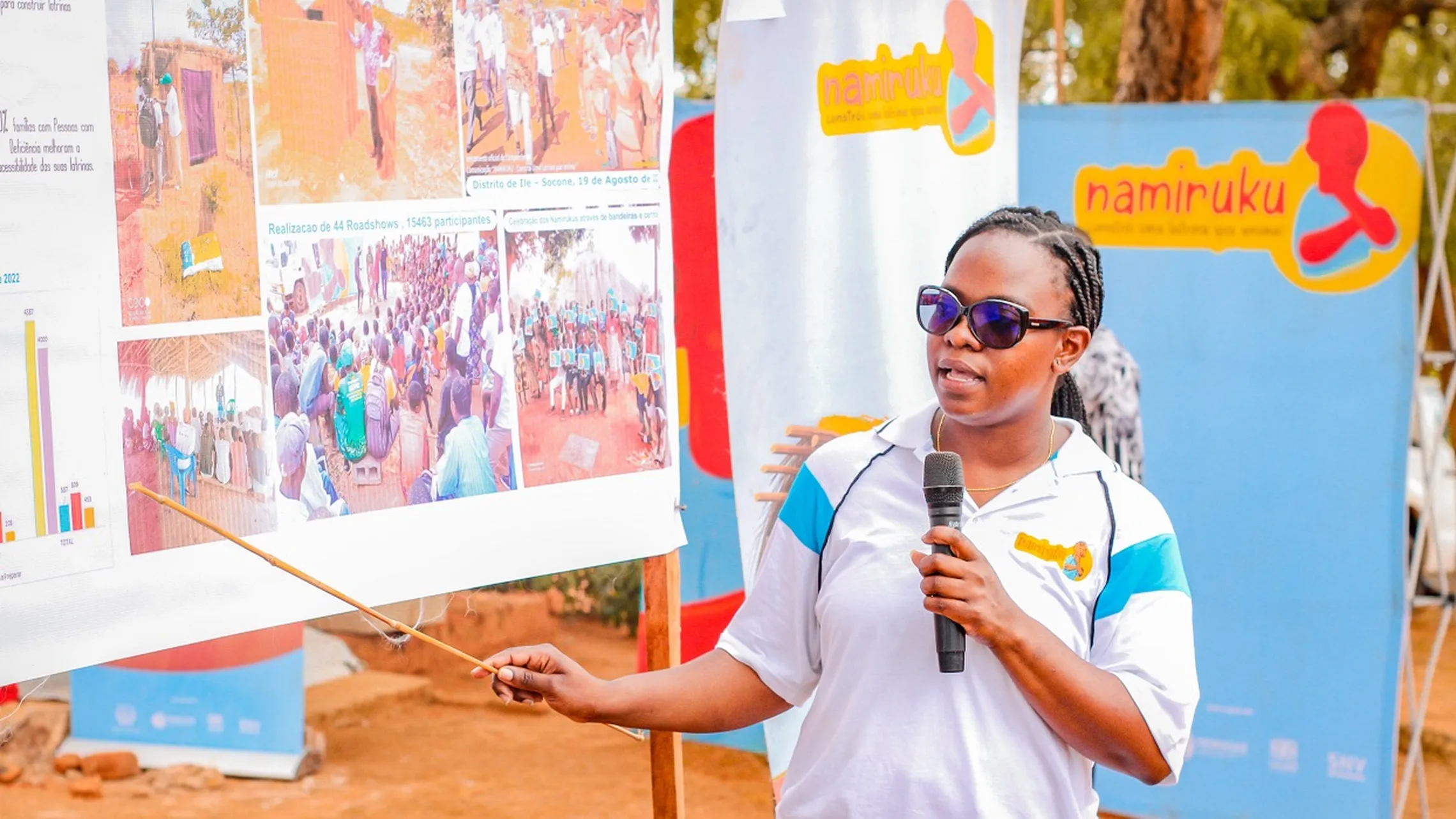Sturdier toilets in rural Mozambique in three months?
It is possible - 4,500 households in Mozambique's Alto Molocué and Ile districts build sturdier toilets after a three-month BCC campaign by SNV and PRONASAR partners

Many people have the capacity to improve their own sanitation conditions, if they know what to do, who to call, and/or are aware of the benefits and financial returns of having access to sanitation.
Atália Melo’s family is among the 4,500 households in Alto Molocué District and Ile District who now enjoys the benefits of having a toilet. According to Atália, her family has had to build three toilets in the last two years (2021-2022). All these toilets ended up collapsing.

Smiling woman in front of her newly built toilet
'We had an improvised latrine in the past, but after a few months, it collapsed. So, we started to use it only at night. That way, no one could see us. Now we feel good because before it looked like we were defecating outside. And when it rained, we would get soaked by the rain.
Atália Melo, household member
The case of Atália’s family is shared by many others. More than 50% of the communities in Zambézia and Nampula provinces that were declared Open Defecation Free (ODF) between 2016 and 2018 were not able to maintain their ODF status. This was mainly because of rudimentary construction methods applied and flimsy or unresistant materials used, e.g., roof made of leaves and walls of dry grass.
A rapid approach
Namiruku, Build a latrine that enlivens, was implemented over a three-month period, between August and November 2022, with UK aid funding from the UK government to the Mozambican government through its National Rural Water and Sanitation Programme, PRONASAR, and with technical assistance from Upward Spiral. It was an ambitious fast-paced behaviour change communications campaign that was successful in improving the sanitation and hygiene conditions of 4,500 families.
Throughout the three-month period, the communication campaign encouraged households to build resilient latrines using sturdy local and low-cost materials capable of preventing collapse due to heavy rains or termite infestation.[1]
For Fernando Mainque, Provincial Director of Public Works of Zambezia province, ’The promotion of the construction of resilient latrines is only the beginning of a broader work ambition that will require greater commitment from community leaders as well as from the community, so that by 2024 we will all be free from open defecation in Zambezia province.’

Provincial director of Zambezia addressing crowd during Namiruku forum
Factors driving fast results
Some factors that led to the success of this three-month campaign were as follows:
Government leadership – Namiruku was implemented as part of the national government’s Rural Sanitation Strategy and the National Rural Water Supply and Sanitation Programme (PRONASAR).
Joined-up thinking – Intervention designs of the campaign were developed within a behavioural change hub partnership that brought together knowledge and skills from multiple countries for adaptation and/or replication. Engaging in a hub approach enabled SNV and the Government of Mozambique to reduce time spending for designing a new campaign.
Long-term partnerships – focused on delivering to the objectives of PRONASAR did not only enable the financing needed for the sanitation ambition, but it also contributed to the growing number of tried and tested approaches and methodologies helpful in strengthening the institutional fabric of WASH governance. [2,3]

Presentation of Namiruku campaign results by SNV WASH Advisor
Forty-four roadshows and 266 community workshops after, over 4,000 families participated in Namiruku training opportunities. Through BCC how-to videos and radio spots, more than 22,000 people in the two districts gained access to information on the importance of and how to build a resilient toilet.
The impressive results of this three-month campaign have spread to neighbouring districts, with several local communities expressing interest to engage in similar BCC activities. A survey will soon be conducted with interested districts to help adapt Namiruku in their own contexts.
Notes
[1] A sturdy and resilient latrine would have a solid foundation or ground – preferably, made of adobe or cement block walls; a roof made of sticks, grass, and/or zinc sheets; a secure door for privacy; proper ventilation; and a place for washing hands with water and detergent or soap.
[2] The UK government has been a long-time Water and WASH partner of SNV in several countries. In Mozambique, more recent multi-country sanitation and hygiene projects include the Hygiene and Behaviour Change Coalition (HBCC) project and Sustainable Sanitation and Hygiene for All Results Programme (SSH4A RP).
[3] SNV's decade-long partnership with the Governments of Bhutan and Australia is another example of what long-term partnerships can accomplish. In November 2022, Bhutan celebrated a huge sanitation milestone for ending open defecation and bringing improved toilets to the entire population of Bhutan.
Banner photo: Community leader in Zambezia province standing proudly in front of his new toilet. Photo credit: SNV.

